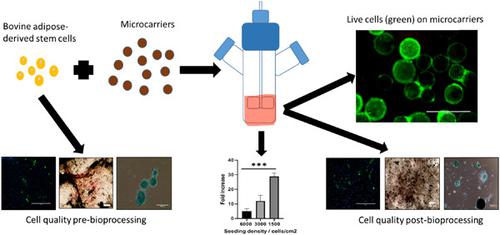当前位置:
X-MOL 学术
›
Biotechnol. Bioeng.
›
论文详情
Our official English website, www.x-mol.net, welcomes your feedback! (Note: you will need to create a separate account there.)
Bioprocess development for scalable production of cultivated meat.
Biotechnology and Bioengineering ( IF 3.8 ) Pub Date : 2020-06-22 , DOI: 10.1002/bit.27469 Mariana P Hanga 1 , Junaid Ali 1 , Panagiota Moutsatsou 1 , Fritz A de la Raga 1 , Christopher J Hewitt 1 , Alvin Nienow 1, 2 , Ivan Wall 1
Biotechnology and Bioengineering ( IF 3.8 ) Pub Date : 2020-06-22 , DOI: 10.1002/bit.27469 Mariana P Hanga 1 , Junaid Ali 1 , Panagiota Moutsatsou 1 , Fritz A de la Raga 1 , Christopher J Hewitt 1 , Alvin Nienow 1, 2 , Ivan Wall 1
Affiliation

|
Traditional farm‐based products based on livestock are one of the main contributors to greenhouse gas emissions. Cultivated meat is an alternative that mimics animal meat, being produced in a bioreactor under controlled conditions rather than through the slaughtering of animals. The first step in the production of cultivated meat is the generation of sufficient reserves of starting cells. In this study, bovine adipose‐derived stem cells (bASCs) were used as starting cells due to their ability to differentiate towards both fat and muscle, two cell types found in meat. A bioprocess for the expansion of these cells on microcarriers in spinner flasks was developed. Different cell seeding densities (1,500, 3,000, and 6,000 cells/cm2) and feeding strategies (80%, 65%, 50%, and combined 80%/50% medium exchanges) were investigated. Cell characterization was assessed pre‐ and postbioprocessing to ensure that bioprocessing did not negatively affect bASC quality. The best growth was obtained with the lowest cell seeding density (1,500 cells/cm2) with an 80% medium exchange performed (p < .0001) which yielded a 28‐fold expansion. The ability to differentiate towards adipogenic, osteogenic, and chondrogenic lineages was retained postbioprocessing and no significant difference (p > .5) was found in clonogenicity pre‐ or postbioprocessing in any of the feeding regimes tested.
中文翻译:

可规模化生产人造肉的生物工艺开发。
基于牲畜的传统农场产品是温室气体排放的主要贡献者之一。人造肉是一种模仿动物肉的替代品,在受控条件下在生物反应器中生产,而不是通过屠宰动物。培养肉生产的第一步是产生足够的起始细胞储备。在这项研究中,牛脂肪干细胞 (bASC) 被用作起始细胞,因为它们能够分化为脂肪和肌肉,这两种细胞类型在肉中发现。开发了用于在旋转瓶中的微载体上扩增这些细胞的生物过程。不同的细胞接种密度(1,500、3,000 和 6,000 个细胞/cm 2) 和喂养策略(80%、65%、50% 和组合的 80%/50% 培养基交换)进行了研究。在生物加工前和生物加工后评估细胞表征,以确保生物加工不会对 bASC 质量产生负面影响。以最低的细胞接种密度 (1,500 个细胞/cm 2 )获得最佳生长,并进行 80% 培养基交换 ( p < .0001),产生 28 倍的扩增。在生物加工后保留了分化成脂肪、成骨和成软骨谱系的能力,并且 在任何测试的喂养方案中,在生物加工前或生物加工后的克隆形成中都没有发现显着差异(p > .5)。
更新日期:2020-06-22
中文翻译:

可规模化生产人造肉的生物工艺开发。
基于牲畜的传统农场产品是温室气体排放的主要贡献者之一。人造肉是一种模仿动物肉的替代品,在受控条件下在生物反应器中生产,而不是通过屠宰动物。培养肉生产的第一步是产生足够的起始细胞储备。在这项研究中,牛脂肪干细胞 (bASC) 被用作起始细胞,因为它们能够分化为脂肪和肌肉,这两种细胞类型在肉中发现。开发了用于在旋转瓶中的微载体上扩增这些细胞的生物过程。不同的细胞接种密度(1,500、3,000 和 6,000 个细胞/cm 2) 和喂养策略(80%、65%、50% 和组合的 80%/50% 培养基交换)进行了研究。在生物加工前和生物加工后评估细胞表征,以确保生物加工不会对 bASC 质量产生负面影响。以最低的细胞接种密度 (1,500 个细胞/cm 2 )获得最佳生长,并进行 80% 培养基交换 ( p < .0001),产生 28 倍的扩增。在生物加工后保留了分化成脂肪、成骨和成软骨谱系的能力,并且 在任何测试的喂养方案中,在生物加工前或生物加工后的克隆形成中都没有发现显着差异(p > .5)。


























 京公网安备 11010802027423号
京公网安备 11010802027423号